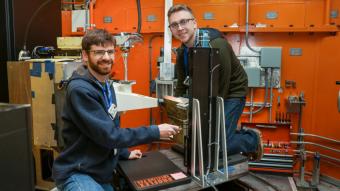Mines researchers use neutrons to study weld-induced stress relief in renewable energy infrastructure

Colorado School of Mines graduate student researchers (left) Ben Schneiderman and Tim Pickle using neutrons at ORNL’s High Flux Isotope Reactor to measure residual stress in welds used to make renewable energy storage tanks. (Image courtesy of ORNL/Genevieve Martin)
[Editor's note: This article first appeared on the Oak Ridge National Laboratory website. ORNL has provided Mines Newsroom with permission to re-share it here.]
By Jeremy Rumsey, Oak Ridge National Laboratory
Welding is an essential part of manufacturing, and the key to making crack-free welds relies on the ability to understand how the weld is put together atom by atom.
Before the COVID-19 pandemic, Tim Pickle and Ben Schneiderman, graduate students at the Center for Welding, Joining and Coatings Research at Colorado School of Mines, used neutrons at the U.S. Department of Energy’s Oak Ridge National Laboratory (ORNL) to improve that understanding. They’re part of a project supported by DOE’s SunShot division and the National Renewable Energy Laboratory (NREL). The goal is to investigate the performance of welds used to build large thermal energy storage tanks at concentrating solar plants—facilities with vast networks of mirrors used to collect solar energy, some stretching several million square feet in size.
“What we’re trying to do is compare the differences in stress profiles between two manufacturing approaches, with and without post-weld heat treatment, used to create the storage tanks,” said Pickle. “We’re also trying to validate a finite element model that can be used by NREL and potential manufacturers to help them determine the best welding and post-weld heat treatment procedures to mitigate and find solutions to cracking problems.”
Specifically, the team is studying stress relaxation cracking (SRC)—the susceptibility of welds to cracking over time due to factors such as internal stress and high temperatures. Thermal fatigue created by alternating stress between room and extremely high temperatures may also contribute to SRC. Each time the metal experiences a change in temperature during the welding process, new stress is added. Those lasting changes, or deformations, called residual stresses, can have a big impact on the performance of the weld during service.
The storage tanks are large structures about 100 feet wide by 30 feet tall. They’re used to store molten salt material that is heated and liquified to store energy captured by solar panels. When energy is needed, the molten salt is pumped into a steam system that boils water, which then spins a turbine that generates electricity.
Essentially, a tank is made by rolling large plates of stainless steel into a cylinder. The ends are then fused together using seam welds, which require multiple layers of weld metal to fill the space in between the weld joints.
“When the welded areas of the wall joints go from room temperature to above 550 or 600 degrees Celsius, they develop stresses around the weld,” said Pickle. “We want to know if we can reduce the tensile stress by using a post-weld heat treatment before the weld goes into service, to extend the lifetime of the weld and mitigate the cracking mechanism we think is happening. To do that, we need to measure the residual stresses.”

Neutrons are the ideal tool for examining residual stress because they penetrate materials deeply to reveal atomic changes in the material’s internal structure. Using the HIDRA instrument (formerly the Neutron Residual Stress Mapping Facility) at ORNL’s High Flux Isotope Reactor, the team performed experiments on 2-inch-thick plates of 347 H stainless steel that were joined using a “40-pass” weld—a large weld consisting of 40 total individual weld beads to fuse the two ends together.
“Less sophisticated approaches to measuring stress involve drilling holes in the metal and measuring how the material deforms around the hole, as some of the residual stress is relieved by drilling. However, that would limit us to only being able to measure residual stresses in limited locations, not to mention that the thickness of the steel in this experiment would have made it even more difficult,” said Schneiderman.
“To get a complete picture of the stress, we need to look at three principal strain directions from plate edge to weld centerline as a function of plate thickness, which neutrons allow us to measure. The technique has evolved to the point where using neutrons to make this sort of measurement has become more widely available to graduate student researchers like us, which really helps us carry out higher-quality investigations to inform the problem of SRC.”
HFIR is a DOE Office of Science User Facility. ORNL is managed by UT-Battelle LLC for DOE’s Office of Science, the single largest supporter of basic research in the physical sciences in the United States. DOE’s Office of Science is working to address some of the most pressing challenges of our time. For more information, visit https://energy.gov/science.




